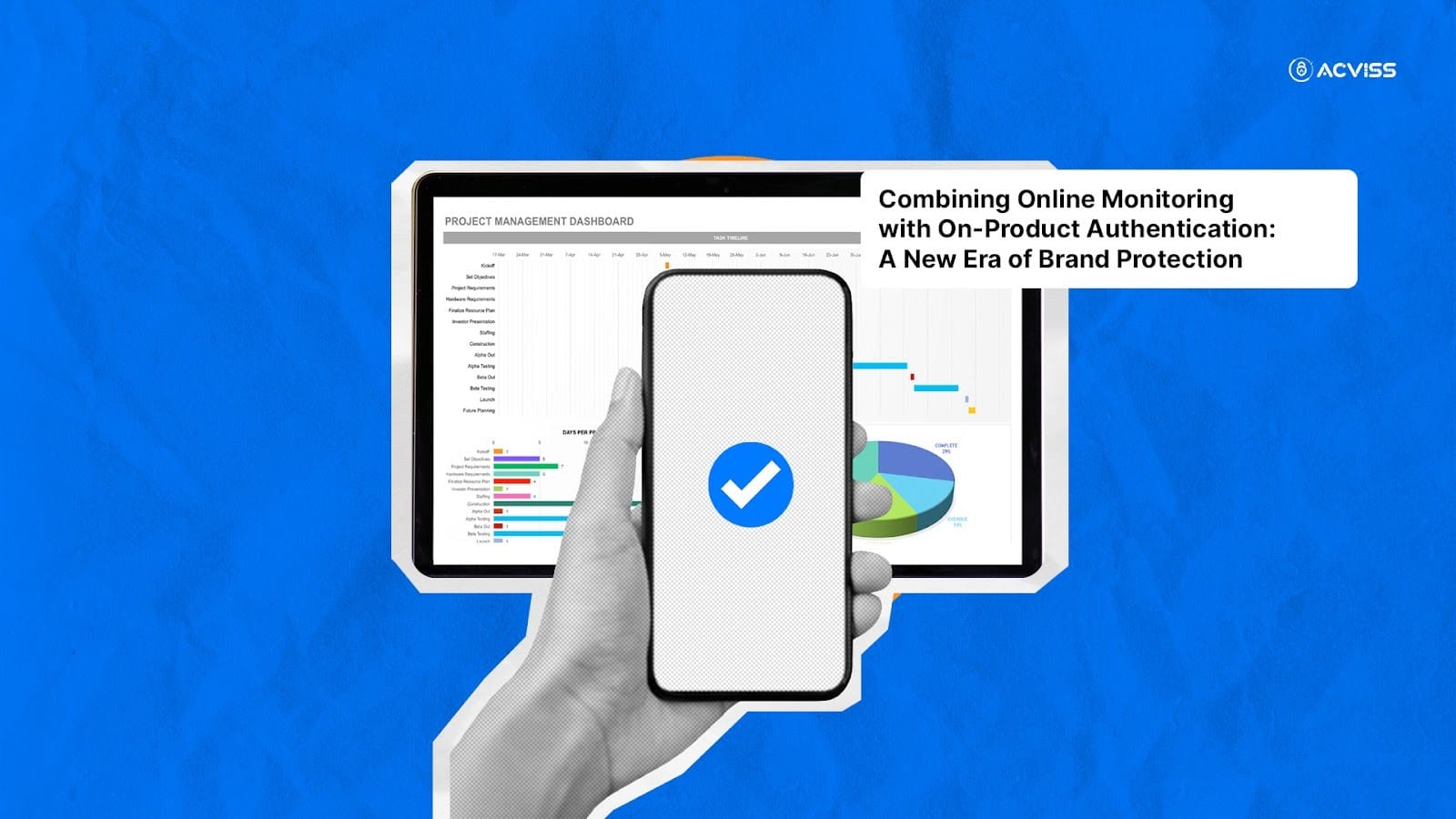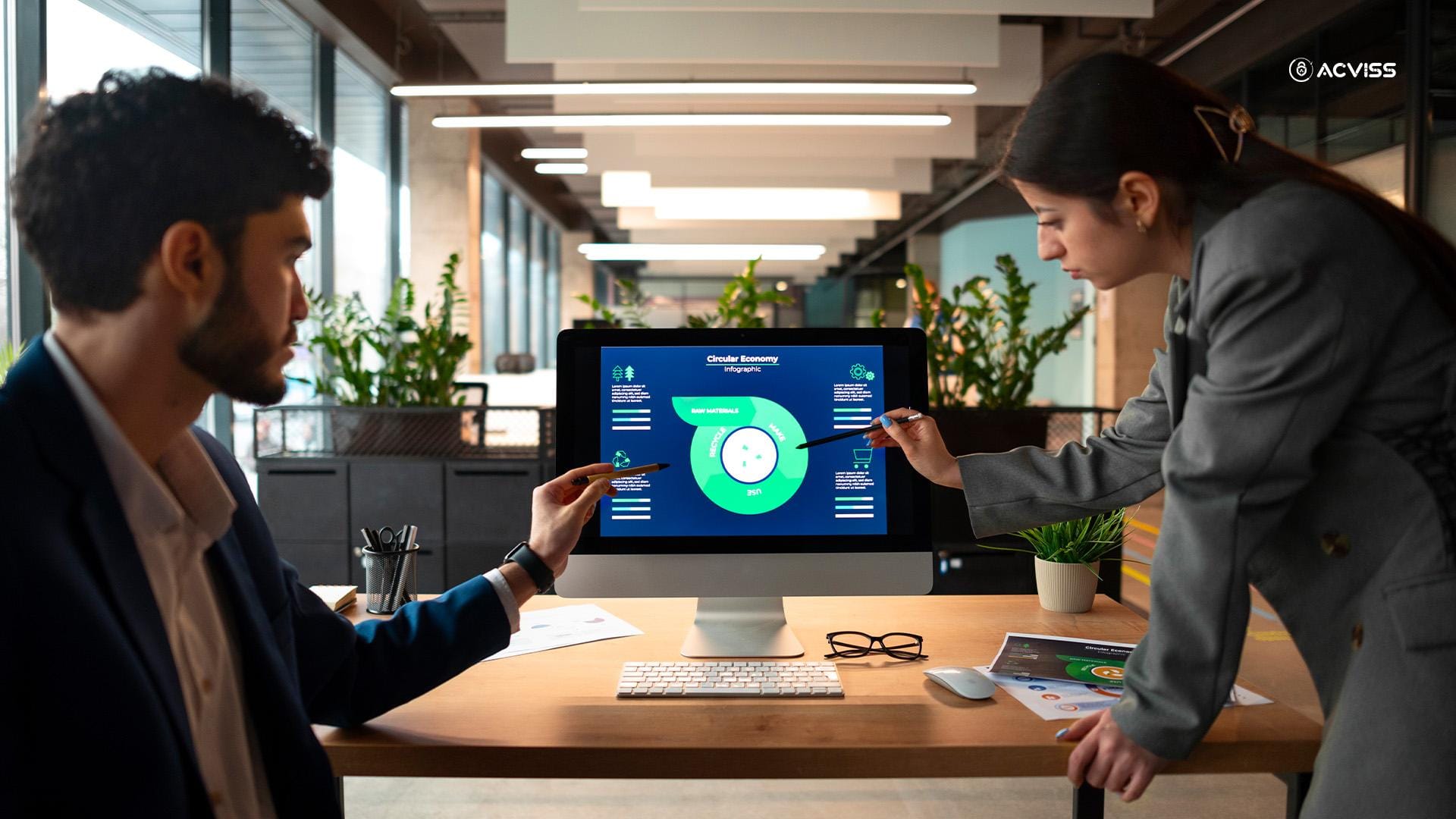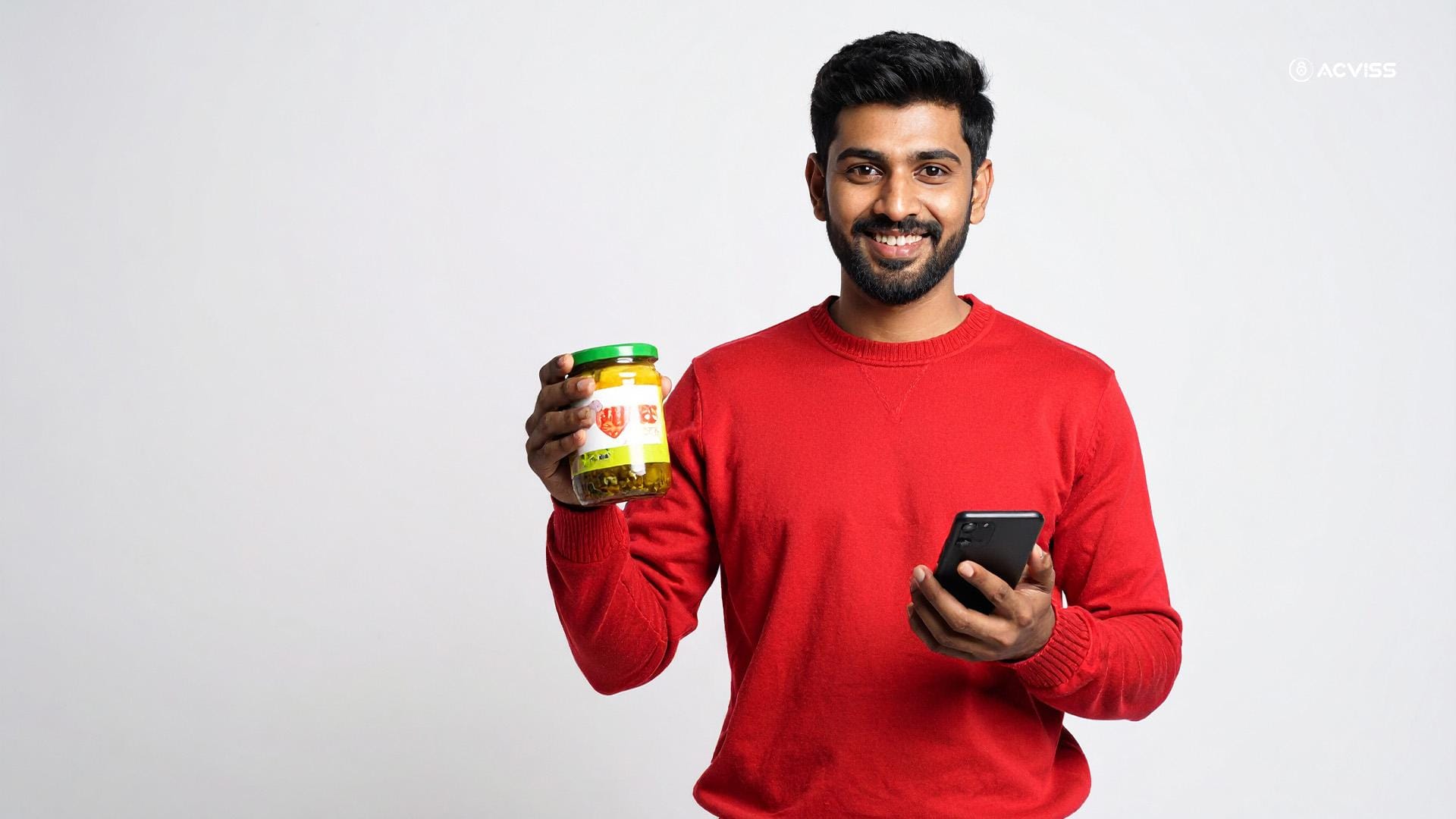Combining Online Monitoring with On-Product Authentication: A New Era of Brand Protection

Brands today are fighting an invisible war, one that unfolds across both digital screens and physical shelves. It’s a battle not only for market share but for trust, reputation, and authenticity. Counterfeiting, grey-market trading, and unauthorised online listings are eroding consumer confidence at an alarming rate.
In the age of global e-commerce and instant connectivity, it’s no longer enough for a company to focus solely on either online brand protection or product authentication. The lines between the digital and the physical worlds have blurred. And with that, the only viable defence lies in combining online monitoring with on-product authentication, a hybrid approach that bridges the gap between cyber vigilance and supply chain traceability.
This integration isn’t just a technological shift; it represents a new philosophy of brand protection and IP enforcement, one that treats authenticity as a continuous process, not a one-time validation.
The Counterfeit Crisis in Numbers
The counterfeiting problem is far from small-scale. According to the OECD, counterfeit and pirated goods now account for over 3.3% of world trade, worth nearly USD 509 billion annually. These fakes infiltrate every industry, including pharmaceuticals, automotive parts, luxury goods, electronics, and even food and beverages.
What’s even more worrying is how digital marketplaces have accelerated this growth. A 2023 EUIPO report found that nearly 80% of counterfeit trade routes now involve online platforms, many of which operate across multiple jurisdictions, making enforcement complex.
In such a landscape, traditional anti-counterfeiting solutions that focus purely on holograms, QR codes, or digital takedown notices are proving insufficient. A brand might remove fake listings online, but counterfeits may still flow unchecked through retail networks. Similarly, a physical authentication label can prevent imitation in stores, yet online replicas continue to deceive customers with counterfeit URLs and social media ads.
The answer lies in integration, where online monitoring systems feed into on-product authentication frameworks, creating a single, intelligent ecosystem that ensures end-to-end brand verification and product safety.
Understanding the Two Worlds: Online Monitoring and On-Product Authentication

Online Monitoring: Protecting the Brand in the Digital Realm
Online brand protection, sometimes referred to as digital IP protection, involves scanning and analysing the web for instances of misuse, infringement, or counterfeiting. Platforms such as Truviss exemplify how AI-driven systems can detect unauthorised sellers, fake product listings, and fraudulent websites in real time.
Through a combination of machine learning algorithms and image recognition, these solutions map a brand’s digital footprint across marketplaces, domains, social media, and app stores. They then identify anomalies such as:
- Duplicate product listings at unusually low prices
- Misuse of brand logos or product images
- Domains or URLs that mimic legitimate brand websites
- Social media profiles impersonating brand representatives
- Paid ads leading to counterfeit product pages
The power of such monitoring lies in its proactive defence. Instead of reacting after damage occurs, AI systems continuously patrol the web, enabling brands to act swiftly, issuing takedowns, reporting violations, and protecting trademark integrity.
However, while online monitoring safeguards the digital identity of a brand, it cannot directly confirm whether a product in a consumer’s hands is genuine. That’s where on-product authentication becomes indispensable.
On-Product Authentication: Ensuring Physical Product Verification
On-product authentication focuses on securing the physical supply chain through technologies embedded directly onto or within the product. It allows consumers, retailers, and enforcement agencies to verify authenticity instantly.
A modern solution like Acviss Certify leverages non-cloneable security codes, which act as unique digital fingerprints for every item produced. These codes cannot be replicated or reused, offering a foolproof layer of verification. When scanned through a smartphone app, they confirm product details such as manufacturing origin, date, and authenticity status.
This level of product verification not only prevents counterfeiters from replicating security labels but also provides brands with valuable data on customer engagement, who is scanning the product, from where, and at what frequency.
In industries such as pharmaceuticals and FMCG, where product safety is paramount, non-cloneable authentication offers peace of mind to both the brand and the consumer.
The Missing Link: Why Integration Is the Future
Despite the sophistication of these individual systems, most brands still operate them in isolation. Online monitoring teams work separately from product authentication departments, often using different data platforms and reporting structures.
The result? Fragmented protection.
Imagine a counterfeit detection team flagging a fake online store selling imitated cosmetics. They take the site down. But the counterfeiters are using identical fake packaging, circulating offline through local distributors. The authentication team, meanwhile, sees rising counterfeit scans in a particular region but lacks the digital evidence to connect those fakes to specific sellers or domains.
Now, consider an integrated system where both teams share a single intelligence platform. A fake listing detected by Truviss triggers an investigation, cross-referenced with Certify data showing increased invalid scans in the same geography. The brand can immediately pinpoint the counterfeit source, connect it to the online activity, and take decisive legal or enforcement action.
This digital-physical feedback loop transforms reactive brand protection into predictive brand intelligence.
Building a Connected Brand Protection Ecosystem

To fully harness this integration, brands need to align three key pillars of their brand authentication and traceability strategy.
1. Unified Data Infrastructure
Both online and offline systems generate vast amounts of data, scan records, domain reports, counterfeit alerts, marketplace listings, and social media mentions. The first step is consolidating this data into a unified brand protection dashboard that provides visibility across both ecosystems.
Machine learning can then correlate anomalies, for example, spikes in counterfeit detections in physical markets that coincide with online promotions from unauthorised sellers. This helps in prioritising enforcement efforts and optimising IP protection budgets.
2. End-to-End Supply Chain Traceability
Integration also extends into supply chain management. A brand cannot achieve true protection unless it knows the complete journey of its product, from factory to customer.
Adopting track and trace technologies helps to implement product traceability at every stage. Blockchain-based traceability, for example, allows immutable recording of transactions, ensuring transparency and accountability. When combined with non-cloneable product codes, it becomes virtually impossible for counterfeit goods to infiltrate legitimate supply chains unnoticed.
The benefits extend beyond anti-counterfeiting. Enhanced traceability helps in regulatory compliance, recall management, and consumer trust, vital elements for long-term brand satisfaction and loyalty.
3. Real-Time Customer Engagement and Verification
The final pillar lies in involving the most powerful ally in the fight against counterfeits, the consumer.
Modern customers expect transparency. By empowering them to authenticate products themselves through product verification apps, brands turn them into active participants in quality assurance.
Every time a consumer scans a Certify code, they not only verify authenticity but also engage directly with the brand. This interaction offers valuable insights into purchasing behaviour, location trends, and post-purchase sentiment.
Integrating these real-world interactions with online monitoring data from systems like Truviss completes the circle, merging human trust with technological intelligence.
How Integration Enhances Brand Protection Across Industries
The impact of combining online monitoring and on-product authentication varies by sector, but the underlying logic remains constant: connect, correlate, and counteract.
Pharmaceuticals and Healthcare
Counterfeit medicines account for nearly 10% of the global drug trade, posing serious health risks. For pharma companies, linking digital monitoring (detecting unauthorised online pharmacies) with on-pack authentication (verifiable non-cloneable labels) ensures product safety and regulatory compliance.
It allows real-time recall tracing, patient verification, and direct communication with consumers about safety alerts or expiration dates.
Electronics and Automotive Parts
Counterfeit electronics and automotive spares not only cause brand damage but also endanger lives. By connecting online detection of fake listings with track and trace systems, manufacturers can isolate counterfeit networks and block fraudulent warranties.
Each genuine component, tagged with a secure digital identifier, becomes verifiable, ensuring safe installation and service across the supply chain.
Luxury and Consumer Goods
Luxury goods face rampant imitation across online marketplaces. Here, brand authentication solutions backed by AI-driven online surveillance enable high-end brands to maintain exclusivity.
Customers can scan non-cloneable labels to confirm authenticity, while the brand monitors resale platforms and social media to detect unauthorised sellers, protecting trademark value and IP reputation.
Data-Driven Insights: Turning Protection into Strategy

When digital monitoring and physical authentication operate in tandem, brands gain access to powerful insights that go beyond anti-counterfeiting.
These insights can help in:
- Demand forecasting: Analysing scan data trends to predict market demand.
- Channel performance: Identifying high-performing distributors and regions.
- Customer satisfaction: Measuring engagement rates through product verification scans.
- Market integrity: Detecting early indicators of grey market activity or product diversion.
Such intelligence transforms brand protection from a cost centre into a strategic business advantage, one that enhances both profitability and customer loyalty.
The Role of AI and Blockchain in Enabling Integration
The convergence of AI and blockchain technology has made the seamless integration of online and offline authentication more achievable than ever.
AI-Powered Online Monitoring
Artificial intelligence enables rapid scanning of thousands of digital assets, marketplaces, websites, and social media posts in real time. Solutions like Truviss use image matching, keyword clustering, and seller profiling to identify potential infringements even before they cause financial damage.
AI’s ability to learn from past data allows continuous improvement in identifying subtle patterns of brand misuse.
Blockchain-Based Traceability
Blockchain brings transparency and immutability to supply chain management. Each transaction or movement of a product is recorded as a block in a distributed ledger, ensuring authenticity at every stage.
When linked with non-cloneable authentication codes of Acviss Yello Labels, blockchain ensures that even if counterfeiters replicate packaging or labels, the absence of a valid blockchain record exposes the fake instantly.
Together, AI and blockchain create a trust infrastructure, one that is decentralised, tamperproof, and verifiable by anyone in the value chain.
Overcoming Implementation Challenges
While the potential is clear, many brands hesitate due to perceived complexity and cost. Implementing a combined system requires both technological investment and organisational change. Common challenges include:
- Data silos between digital marketing, legal, and supply chain teams
- Integration difficulties between legacy systems and new authentication tools
- Lack of skilled resources to interpret and act upon data insights
- Budget constraints for smaller or mid-sized brands
Overcoming these requires a phased approach. Brands can start by introducing non-cloneable authentication on high-risk products, then gradually integrate online monitoring dashboards to link physical and digital data streams.
The long-term gains, in brand trust, trademark protection, and consumer confidence, far outweigh the initial setup efforts.
The Customer as a Partner in Brand Verification

In this new model, the consumer is no longer a passive end-user but an active stakeholder in authenticity. Each scan of a product label or report of a suspicious online listing contributes to a larger brand verification ecosystem.
By making authenticity verification intuitive and rewarding, for instance, integrating loyalty points, safety alerts, or product education, brands can turn protection into engagement.
This dual approach nurtures customer satisfaction and strengthens the emotional bond between brand and buyer. In essence, every authentication becomes a micro-interaction of trust.
Towards a Holistic Model of Brand Integrity
Combining online monitoring with on-product authentication is not just an operational improvement; it’s a paradigm shift. It moves brand protection from a defensive posture to an intelligent, proactive ecosystem that continuously learns, adapts, and protects.
It also aligns perfectly with the growing global emphasis on IP protection and sustainable supply chain transparency. As brands face increasing regulatory scrutiny, traceability will no longer be a choice; it will be a prerequisite for doing business responsibly.
Merging systems like Truviss and Certify creates a seamless layer of trust that spans from the digital domain to the physical product, ensuring that every consumer interaction, whether online or offline, reinforces brand authenticity.
The Future Belongs to Connected Brand Protection
The battle against counterfeiting can no longer be fought on isolated fronts. True protection lies in the fusion of two worlds, where AI monitors the digital realm and non-cloneable technologies secure the physical.
This integration transforms brand protection into a living, breathing network of trust, connecting products, platforms, and people in a shared mission of authenticity.
Brands that embrace this synergy early will not only outpace counterfeiters but also earn something far more valuable: enduring consumer trust.
Interested to learn more? Get in touch with us to explore how advanced on-product authentication and online brand protection solutions can secure your brand across every touchpoint.
